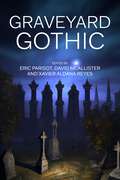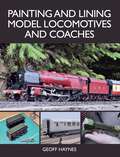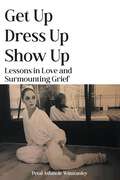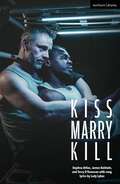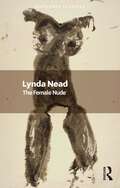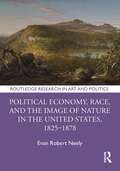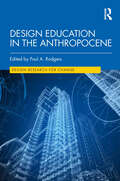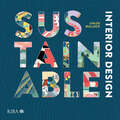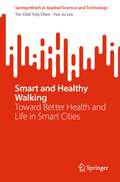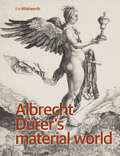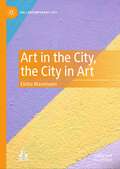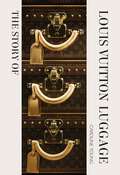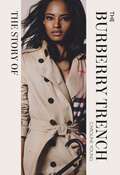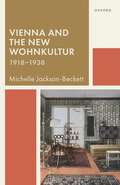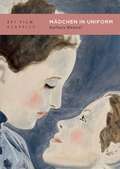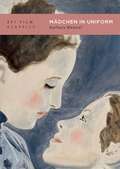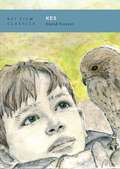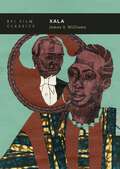- Table View
- List View
Graveyard Gothic
by Eric Parisot David McAllister Xavier Aldana ReyesGraveyard Gothic is the first sustained consideration of the graveyard as a key Gothic locale. This volume examines various iterations of the Gothic graveyard (and other burial sites) from the eighteenth century to the twenty-first, as expressed in numerous forms of culture and media including poetry, fiction, TV, film and video games. The volume also extends its geographic scope beyond British traditions to accommodate multiple cultural perspectives, including those from the US, Mexico, Japan, Australia, India and Eastern Europe. The seventeen chapters from key international Gothic scholars engage a range of theoretical frameworks, including the historical, material, colonial, political and religious. With a critical introduction offering a platform for further scholarship and a coda mapping potential future critical and cultural developments, Graveyard Gothic is a landmark volume defining a new area of Gothic studies.
Painting and Lining Model Locomotives and Coaches
by Geoff HaynesThis lavishly illustrated book provides guidance on how to transform your model from its bare structure to a realistic finish. This new book provides: a guide for both beginners and the more experienced, covering all scales and gauges; advice on the selection of airbrushes, compressors and essential tools; a simple three-step process to clean and prepare your model for painting; guidance on dealing with faults and paint problems; instruction on the pros and cons of the different ways to produce lines; tips to help you produce consistent fine lines with a bow pen; how to get the best out of transfers and the different types available, and finally, basic weathering techniques using a variety of methods. With over 500 colour photographs it will help even the beginner to produce a realistic life-like model.
Get Up, Dress Up, Show Up: Lessons in Love and Surmounting Grief
by Petal Ashmole WinstanleyThis book is about surviving grief, and charts a journey of exceptional love. Now, aged 77, the burden of ambition has left the author and she has, with the help of close confidantes, reconfigured her life. Petal Ashmole Winstanley grew up in Perth, Western Australia with two great loves: her mother and classical ballet. Spurred on by her natural talent and ambition to dance, she made the voyage on the SS Canberra to London in the swinging '60s-the start of a vibrant career encompassing the glamour, global travel and trials and tribulations of a life on the stage. Her journey has been one of creative fulfilment often offset by deep sadness and loss: that of a longed-for baby, and the ultimate grief of losing three husbands. Petal speaks with gut-wrenching honesty of the brutal circumstances leading to each of their deaths, and the heartbreaking aftermath of a grief that would not ease. Repeated hospice experiences allow her to share an intimate knowledge of what happens before, during and after death-and have made her an advocate for early AIDS and cancer detection, and a fierce believer in Dignity in Dying. Sometimes shocking but frequently funny, Petal's story of sorrow is peppered with optimism as she recounts how, even at the gates of hell, she found the strength to get up, dress up and show up, sporting a dash of red lipstick.
Kiss Marry Kill (Modern Plays)
by Daphna Attias James Baldwin Terry O'DonovanI'm a monster. You can't marry me.Jay and Paul are both serving life sentences for homophobic murders. Incredibly, they fall in love and seek permission to marry. Inspired by real-life events, Kiss Marry Kill is a provocative new play that reimagines the first same-sex wedding in a UK prison.The original Dante or Die production featured live music from rapper Lady Lykez, and enveloped audiences in the private spaces and conversations of a world rarely seen. Kiss Marry Kill zeroes in on the limits of our compassion, challenging our assumptions and preconceptions around sexuality, and the criminal justice system. This edition was published to coincide with the world premiere Dante or Die tour starting in March 2024.
Kiss Marry Kill (Modern Plays)
by Daphna Attias James Baldwin Terry O'DonovanI'm a monster. You can't marry me.Jay and Paul are both serving life sentences for homophobic murders. Incredibly, they fall in love and seek permission to marry. Inspired by real-life events, Kiss Marry Kill is a provocative new play that reimagines the first same-sex wedding in a UK prison.The original Dante or Die production featured live music from rapper Lady Lykez, and enveloped audiences in the private spaces and conversations of a world rarely seen. Kiss Marry Kill zeroes in on the limits of our compassion, challenging our assumptions and preconceptions around sexuality, and the criminal justice system. This edition was published to coincide with the world premiere Dante or Die tour starting in March 2024.
The Female Nude: Art, Obscenity and Sexuality (Routledge Classics)
by Lynda NeadThe history of Western art is saturated with images of the female body. Lynda Nead's The Female Nude was the first book to critically examine this phenomenon from a feminist perspective and ask: how and why did the female nude acquire this status?In a deft and engaging manner, Lynda Nead explores the ways in which acceptable and unacceptable images of the female body are produced, issues which have been reignited by current controversies around the patriarchy, objectification and pornography. Nead brilliantly illustrates the two opposing poles occupied by the female nude in the history of art; at one extreme the visual culmination of enlightenment aesthetics; at the other, spilling over into the degraded and the obscene. What both have in common, however, is the aim of containing the female body.Drawing on examples of art and artists from the classical period to the 1980s, The Female Nude paints a devastating picture of the depiction of the female body and remains as fresh and invigorating today as it was at the time of its first publication.This Routledge Classics edition includes a new Preface by the author.
The Female Nude: Art, Obscenity and Sexuality (Routledge Classics)
by Lynda NeadThe history of Western art is saturated with images of the female body. Lynda Nead's The Female Nude was the first book to critically examine this phenomenon from a feminist perspective and ask: how and why did the female nude acquire this status?In a deft and engaging manner, Lynda Nead explores the ways in which acceptable and unacceptable images of the female body are produced, issues which have been reignited by current controversies around the patriarchy, objectification and pornography. Nead brilliantly illustrates the two opposing poles occupied by the female nude in the history of art; at one extreme the visual culmination of enlightenment aesthetics; at the other, spilling over into the degraded and the obscene. What both have in common, however, is the aim of containing the female body.Drawing on examples of art and artists from the classical period to the 1980s, The Female Nude paints a devastating picture of the depiction of the female body and remains as fresh and invigorating today as it was at the time of its first publication.This Routledge Classics edition includes a new Preface by the author.
Political Economy, Race, and the Image of Nature in the United States, 1825–1878 (Routledge Research in Art and Politics)
by Evan Robert NeelyPolitical Economy, Race, and the Image of Nature in the United States, 1825–1878 is an interdisciplinary work analyzing the historical origins of a dominant concept of Nature in the culture of the United States during the period of its expansion across the continent.Chapters analyze the ways in which “Nature” became a discursive site where theories of race and belonging, adaptation and environment, and the uses of literary and pictorial representation were being renegotiated, forming the basis for an ideal of the human and the nonhuman world that is still with us. Through an interdisciplinary approach involving the fields of visual culture, political economy, histories of racial identity, and ecocritical studies, the book examines the work of seminal figures in a variety of literary and artistic disciplines and puts the visual culture of the United States at the center of intellectual trends that have enormous implications for contemporary cultural practice.The book will be of interest to scholars working in art history, visual culture, American studies, environmental studies/ecocriticism, critical race theory, and semiotics.
Political Economy, Race, and the Image of Nature in the United States, 1825–1878 (Routledge Research in Art and Politics)
by Evan Robert NeelyPolitical Economy, Race, and the Image of Nature in the United States, 1825–1878 is an interdisciplinary work analyzing the historical origins of a dominant concept of Nature in the culture of the United States during the period of its expansion across the continent.Chapters analyze the ways in which “Nature” became a discursive site where theories of race and belonging, adaptation and environment, and the uses of literary and pictorial representation were being renegotiated, forming the basis for an ideal of the human and the nonhuman world that is still with us. Through an interdisciplinary approach involving the fields of visual culture, political economy, histories of racial identity, and ecocritical studies, the book examines the work of seminal figures in a variety of literary and artistic disciplines and puts the visual culture of the United States at the center of intellectual trends that have enormous implications for contemporary cultural practice.The book will be of interest to scholars working in art history, visual culture, American studies, environmental studies/ecocriticism, critical race theory, and semiotics.
Design Education in the Anthropocene (Design Research for Change)
This volume examines emerging practice and research in design education rooted in the context of significant global issues.A diverse set of international contributors present novel design education research that seeks to make significant social, economic, cultural and environmental change. Topics covered include fashion, sustainability, creativity, social justice, museum education, climate change, environmentalism, and empathy. The chapters draw a link between current research practice and theory and future challenges for the field.The book will be of interest to scholars working in communication design, graphic design, design research, and information design.
Design Education in the Anthropocene (Design Research for Change)
by Paul A. RodgersThis volume examines emerging practice and research in design education rooted in the context of significant global issues.A diverse set of international contributors present novel design education research that seeks to make significant social, economic, cultural and environmental change. Topics covered include fashion, sustainability, creativity, social justice, museum education, climate change, environmentalism, and empathy. The chapters draw a link between current research practice and theory and future challenges for the field.The book will be of interest to scholars working in communication design, graphic design, design research, and information design.
Sustainable Interior Design
by Chloe BullockWhat does it mean to be a sustainable interior designer? Where do you start? This book demystifies how to be a sustainable interior designer, both within practice and on design projects. It gives you the tools to educate clients that sustainable practice isn’t necessarily more expensive, and what the options available to them are in terms of design concept, materials and finishes. Importantly, the book also looks at sustainable supply chains, particularly important when specifying FF+E. Where to start being sustainable can be a difficult decision. Acting as a primer for interior designers at any stage of their career, it outlines what you really need – and don’t need – to know. Inspirational case studies from around the world sit alongside crucial guidance on the benefits of being sustainable and how to work with enlightened clients. There is information on how sustainable design contributes to health and wellbeing, all backed up by authoritative best practice guidance.
Sustainable Interior Design
by Chloe BullockWhat does it mean to be a sustainable interior designer? Where do you start? This book demystifies how to be a sustainable interior designer, both within practice and on design projects. It gives you the tools to educate clients that sustainable practice isn’t necessarily more expensive, and what the options available to them are in terms of design concept, materials and finishes. Importantly, the book also looks at sustainable supply chains, particularly important when specifying FF+E. Where to start being sustainable can be a difficult decision. Acting as a primer for interior designers at any stage of their career, it outlines what you really need – and don’t need – to know. Inspirational case studies from around the world sit alongside crucial guidance on the benefits of being sustainable and how to work with enlightened clients. There is information on how sustainable design contributes to health and wellbeing, all backed up by authoritative best practice guidance.
Smart and Healthy Walking: Toward Better Health and Life in Smart Cities (SpringerBriefs in Applied Sciences and Technology)
by Tin-Chih Toly Chen Yun-Ju LeeThis book examines smart technologies and their invaluable role in augmenting the walking experience of mobile users. From meticulously planned walking routes to precise footprint detection and analysis, as well as cutting-edge fall detection and prevention mechanisms, these intelligent technologies have the potential to revolutionize healthy and smart walking. Against the backdrop of the post-COVID-19 era, where unrestricted mobility has become pivotal for restoring normalcy, the demand for smart healthcare solutions has soared. The book explores latest advances in sensor technology, cloud computing, deep learning, and networking and related innovative applications that can leverage smart technologies to enhance healthy walking.
Albrecht Dürer’s material world
by Edward H. Wouk Jennifer SpinksThe painter and printmaker Albrecht Dürer is one of the most important figures of the German Renaissance. This book accompanies the first major exhibition of the Whitworth art gallery’s outstanding Dürer collection in over half a century. It offers a new perspective on Dürer as an intense observer of the worlds of manufacture, design and trade that fill his graphic art.Artworks and artefacts examined here expose understudied aspects of Dürer’s art and practice, including his attentive examination of objects of daily domestic use, his involvement in economies of local manufacture and exchange, the microarchitectures of local craft and, finally, his attention to cultures of natural and philosophical inquiry and learning.
Albrecht Dürer’s material world
by Edward H. Wouk and Jennifer SpinksThe painter and printmaker Albrecht Dürer is one of the most important figures of the German Renaissance. This book accompanies the first major exhibition of the Whitworth art gallery’s outstanding Dürer collection in over half a century. It offers a new perspective on Dürer as an intense observer of the worlds of manufacture, design and trade that fill his graphic art.Artworks and artefacts examined here expose understudied aspects of Dürer’s art and practice, including his attentive examination of objects of daily domestic use, his involvement in economies of local manufacture and exchange, the microarchitectures of local craft and, finally, his attention to cultures of natural and philosophical inquiry and learning.
Art in the City, the City in Art (The Contemporary City)
by Elisha MasemannThis Book examines an interplay between discourses on the city that stress the need for rational-functional order and art’s imaginative deviations from the topdown structures of urban life. Moving between theory and praxis, the book situates the city as both a concept and physical construct through which lives and possibilities are shaped or defined. In response, certain modalities of art create spontaneous, non-rational and playful interludes that risk escape from the urban apparatus and a hyper-valorisation of rational order. A three-part framework is used to discuss this push-pull dynamic and to assess the strategies of shock, performative embodiment and intervention that emerged in post-war art movements and in contemporary performance and participatory art practices. The book examines how the disturbances introduced by artists throw the city construct into sharp relief, making it visible and activating momentary encounters where new modes of expression can emerge. This Book offers a new approach to interdisciplinary studies of art and urbanity. The book aims to delineate how the city—as concept and construct—is made visible through artistic practice and in turn challenged or interrogated. Students, researchers and professionals with an interest in the interaction between art and urban studies will discover a new perspective on how urban conditions and issues have been addressed through artistic practice. The book contributes to an evolving discourse in the urban humanities through an exposition of the city’s default construct that is made visible or reimagined through visual art in public spaces.
The Story of Louis Vuitton Luggage
by Laia Farran GravesWith a dedication to luxury and practicality, Louis Vuitton designed his unique lightweight, airtight luggage in 1854 and ensured that jetsetters all over the globe could travel in comfort and style. It was a creation that founded a fashion house and became a standard-bearer for all travel pieces of the future.Exploring the history from traditional box-making to the revolution of the stackable trunk to modern-day artistic collaborations, the book captures the story and craftmanship behind this status symbol and how the luggage continues to define the spirit of travel. From the unmistakable Monogram canvas to the unpickable lock, the steamer trunk to the Speedy, every detail and feature is unveiled.
The Story of the Burberry Trench
by Caroline YoungThe epitome of British heritage fashion, the Burberry trench coat is a beloved wardrobe classic. Practical yet versatile; it is sleek and sexy but also a preppy favourite. Since the launch of the coat in 1912, Burberry has unveiled a selection of styles that has reached iconic stature – and here you will discover their original designs, seasonal adaptations and limited editions.The book also takes a behind-the-scenes look at the craftsmanship, the preloved market and how to authenticate a Burberry. So, whether you are considering buying retail or secondhand, dressing for weather or fashion, this is your ultimate guide to the world's most famous coat.
Vienna and the New Wohnkultur, 1918-1938
by Michelle Jackson-BeckettWhile the domestic sphere might seem tangential to the dire political situation and humanitarian crises of interwar Europe, it was nevertheless at the forefront of debates about cultural identity and economic policy in the Viennese press, culture, and arts. Vienna and the New Wohnkultur, 1918-1938 explores why and how the Viennese design landscape was set apart--aesthetically and theoretically--from other European explorations of modern design. Jackson-Beckett examines interior design exhibitions, press, and debates about modern living in interwar Vienna, an overlooked area of modern European architecture and design history, arguing for a reconsideration of the contours of European modernism. The text analyses varied interpretations of modern domestic culture (Wohnkultur) in Vienna, and explores why these interpretations were distinct from other strands of European modernism. Vienna and the New Wohnkultur introduces new research and translation of primary sources on flexible, adaptable, and affordable design by architects, designers, and retailers. Vienna's design discourse also prefigured important postmodern and contemporary discussions on historicism, eclecticism, empathy, and user experience. Through extensive new research in archival and period sources, Jackson-Beckett illustrates how design ideas, taste, and portrayals of domestic culture of fin-de-si?cle Viennese Modernism (Wiener Moderne) were also deployed as forms of cultural and national identity both during the early years of the Social Democratic government in Vienna (1918-1934) and later under the fascist state (1934-1938).
Mädchen in Uniform (BFI Film Classics)
by Barbara MennelLeontine Sagan's Mädchen in Uniform (1931) is a groundbreaking German film that showcases women's agency and desire behind and in front of the camera.Adapted from Christa Winsloe's lesbian play, the story follows Manuela, an orphan in a boarding school for impoverished Prussian nobility. When she declares her love with her female teacher, the oppressive principal punishes her, leading to a desperate suicide attempt.Barbara Mennel's compelling study firmly establishes Mädchen in the Weimar cinema canon. Mennel contextualises the film in 1920s theories of sexuality and the conventions of modernist cinema. She contrasts its international success to the extensive censorship battles that surrounded it. The film's unique transnational and fragmented history results from the exile of many of its makers during the Nazi regime. By attending to the many remakes throughout the 20th and 21st century, Mennel underscores the film's timeless impact that continues to resonate with contemporary audiences.
Mädchen in Uniform (BFI Film Classics)
by Barbara MennelLeontine Sagan's Mädchen in Uniform (1931) is a groundbreaking German film that showcases women's agency and desire behind and in front of the camera.Adapted from Christa Winsloe's lesbian play, the story follows Manuela, an orphan in a boarding school for impoverished Prussian nobility. When she declares her love with her female teacher, the oppressive principal punishes her, leading to a desperate suicide attempt.Barbara Mennel's compelling study firmly establishes Mädchen in the Weimar cinema canon. Mennel contextualises the film in 1920s theories of sexuality and the conventions of modernist cinema. She contrasts its international success to the extensive censorship battles that surrounded it. The film's unique transnational and fragmented history results from the exile of many of its makers during the Nazi regime. By attending to the many remakes throughout the 20th and 21st century, Mennel underscores the film's timeless impact that continues to resonate with contemporary audiences.
Kes (BFI Film Classics)
by David ForrestKen Loach's 1969 drama Kes, considered one of the finest examples of British social realism, tells the story of Billy, a working class boy who finds escape and meaning when he takes a fledgling kestrel from its nest.David Forrest's study of the film examines the genesis of the original novel, Barry Hines' A Kestrel for a Knave (1968), the eventual collaboration that brought it to the screen, and the film's funding and production processes. He provides an in depth analysis of key scenes and draws on archival sources to shed new light on the film's most celebrated moments. He goes on to consider the film's lasting legacy, having influenced films like Ratcatcher (1999) and This is England (2006), both in terms of its contribution to film history and as a document of political and cultural value. He makes a case for the film's renewed relevance in our present era of systemic economic (and regional) inequality, alienated labour, increasingly narrow educational systems, toxic masculinity, and ecological crisis. Kes endures, he argues, because it points towards the possibility for emancipation and fulfilment through a more responsive and nurturing approach to education, a more delicate and symbiotic relationship with landscape and the non-human, and an emotional articulacy and sensitivity shorn of the rigid expectations of gender.
Xala (BFI Film Classics)
by James S. WilliamsXala (1974) by the pioneering Senegalese director Ousmane Sembene, was acclaimed on its release for its scorching critique of postcolonial African society, and it cemented Sembene's status as a wholly new kind of politically engaged, pan-African, auteur film-maker. Centring on the story of businessman El Hadji and the impotence that afflicts him on his marriage to a young third wife, Xala vividly captures the cultural and political upheaval of 1970s Senegal, while suggesting the radical potential of dissent, solidarity and collective action, embodied by El Hadji's student daughter Rama and the group of urban 'undesirables' who act as a kind of raw chorus to the affairs of the neocolonial elite. James S. Williams's lucid study traces Xala's difficult production history and analyses its daring combination of political and domestic drama, oral narrative, social realism, symbolism, satire, documentary, mysticism and Marxist analysis. Yet from its dazzling extended opening sequence of revolution as performance to its suspended climax of redemption through ritualised spitting, Xala presents a series of conceptual and formal challenges that resist a simple reading of the film as allegory. Highlighting often overlooked elements of Sembene's intricate, experimental film-making, including provocative shifts in mood and poetic, even subversively erotic, moments, Williams reveals Xala as a visionary work of both African cinema and Third Cinema that extended the parameters of postcolonial film practice and still resounds today with its searing inventive power.
Xala (BFI Film Classics)
by James S. WilliamsXala (1974) by the pioneering Senegalese director Ousmane Sembene, was acclaimed on its release for its scorching critique of postcolonial African society, and it cemented Sembene's status as a wholly new kind of politically engaged, pan-African, auteur film-maker. Centring on the story of businessman El Hadji and the impotence that afflicts him on his marriage to a young third wife, Xala vividly captures the cultural and political upheaval of 1970s Senegal, while suggesting the radical potential of dissent, solidarity and collective action, embodied by El Hadji's student daughter Rama and the group of urban 'undesirables' who act as a kind of raw chorus to the affairs of the neocolonial elite. James S. Williams's lucid study traces Xala's difficult production history and analyses its daring combination of political and domestic drama, oral narrative, social realism, symbolism, satire, documentary, mysticism and Marxist analysis. Yet from its dazzling extended opening sequence of revolution as performance to its suspended climax of redemption through ritualised spitting, Xala presents a series of conceptual and formal challenges that resist a simple reading of the film as allegory. Highlighting often overlooked elements of Sembene's intricate, experimental film-making, including provocative shifts in mood and poetic, even subversively erotic, moments, Williams reveals Xala as a visionary work of both African cinema and Third Cinema that extended the parameters of postcolonial film practice and still resounds today with its searing inventive power.
